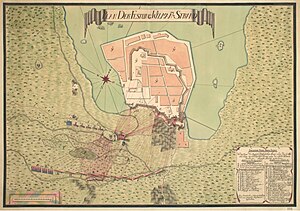Battle of Villmanstrand
| Battle of Villmanstrand | |||||||
|---|---|---|---|---|---|---|---|
| Part of the Russo-Swedish War (1741–1743) | |||||||
 Map of the battle of Villmanstrand | |||||||
| |||||||
| Belligerents | |||||||
|
|
| ||||||
| Commanders and leaders | |||||||
|
Carl Henrik Wrangel (POW) Ernst Gustaf von Willebrand (POW) | Peter von Lacy | ||||||
| Strength | |||||||
|
Swedish estimates: 3,000[1]–4,000[2][3] Russian estimates: 5,256[4]–5,600[5] |
Russian estimates: 10,000[5] Swedish estimates: 13,000[1]–18,000[6] | ||||||
| Casualties and losses | |||||||
|
Swedish estimates: 1,000 killed or wounded[7] 1,345 captured[8] Russian estimates: 3,300[5]–4,000 killed or wounded[8] 1,337 captured[5] |
Russian estimates: 515 killed 1,870 wounded[5] | ||||||
The Battle of Villmanstrand,[a] also the storming of Villmanstrand,[9] was fought during the Russo-Swedish War on 23 August 1741,[10] when Russian forces of 10,000 men[5] (13,000,[1] or 16,000–18,000,[6] according to Swedish estimates), under the command of General Peter von Lacy, assaulted Villmanstrand (Finnish: Lappeenranta).
Fighting began around 2 P.M. but the Swedes, counting 3,000[1]–4,000 men[2] (5,256[4]–5,600[5] according to Russian estimates) withdrew already at 5 P.M.
Swedish casualties amounted to between 2,000 and 2,500 men,[8][7] or 3,300[5]–4,000[8] killed and wounded, and 1,337 captured (among them General Carl Henrik Wrangel), with four colours, 12 cannons and one mortar lost according to Russian estimates.[5] Soon after, the Swedes rallied 1,400 men from the Södermanland (300), Dalarna (above 400), Västerbotten (above 300), and Tavastehus (370) regiments[2] (including sick or elsewhere commanded troops not present at the battle).[11] This number does not count the Karelian Dragoons, Savolax Regiment or the Willebrand infantry which were the first Swedish units to flee and thus suffered the least casualties.[2]
The Russians admitted a loss of 515 killed and 1,870 wounded.[5] After the battle, the Swedes claim to have received reports from captured Russian officers stating a loss of 8,000 Russians killed.[6] Von Lacy did not continue his movement after the battle. Henrik Magnus Buddenbrock was executed for his perceived incompetence.
Swedish units
Russian Colonel Christoph Hermann Manstein's estimates of the Swedish strength, reportedly derived from Wrangel's muster roll at the day of the battle.[12] It is unknown if this also includes sick and elsewhere commanded soldiers not present at the battle. Manstein's figures does, however, include the Kymmenegård (Kiminogon) battalion and the second Savolax battalion, neither of which were present at the battle (these are struck through).[4]
- Dalarna Regiment—623 men[12] (311 killed or captured, 44 wounded)[13]
- Södermanland Regiment—681 men[12]
- Västerbotten Regiment—594 men[12] (157 killed or captured)[14]
- Savolax Regiment—
876 men/one battalion[12][4][b] - Tavastehus Regiment—955 men[12]
- Willebrand Regiment—432 men[12]
- Kymmenegård (Kiminogon) battalion—
476 men/none[12][4] - Karelian Dragoons—506 men[12]
- Artillery personnel—113 men[12]
Notes
References
- ^ a b c d Arwidsson 1854, p. 353.
- ^ a b c d Malmström 1863, p. 318.
- ^ a b Bergenstråhle 1917, p. 296.
- ^ a b c d e Malmström 1863, pp. 317–318.
- ^ a b c d e f g h i j Novitsky 1912, pp. 387–388.
- ^ a b c ten Hoorn 1744, p. 603.
- ^ a b Bergenstråhle 1917, p. 299.
- ^ a b c d Malmström 1863, p. 320.
- ^ Black, Jeremy (1994). European Warfare, 1660–1815. Routledge. p. 175. ISBN 9781135369545.
- ^ Paasikivi & Talka 2018, p. 537.
- ^ Pihlström & Westerlund 1910, p. 67.
- ^ a b c d e f g h i j Manstein 1770, p. 204.
- ^ Pihlström & Westerlund 1910, pp. 66–67.
- ^ Bergenstråhle 1917, p. 300.
Sources
- Malmström, Carl Gustaf (1863). Sveriges politiska historia: från K. Carl XII: s död till statshvaelfningen 1772, Volume 2 (in Swedish). Stockholm: Hjerta. OCLC 457964593.
- Novitsky, Vasily Fedorovich (1912). Sytin Military Encyclopedia: Volume 6. Верещагин — Воинская повинность. Тип. Т-ва И.Д. Сытина. (in Russian). St. Petersburg: Ivan Sytin.
- Arwidsson, Adolph Ivar (1854). Handlingar till upplysning af Finlands häfder, Volume 7 (in Swedish). Stockholm: Norstedt. OCLC 558098460.
- ten Hoorn, Nicolaas (1744). Maandelyksche berichten uit de andere waerelt; of de spreekende dooden: Bestaande in redeneeringen tusschen allerhande verstorvene potentaten en personagien van rang; zo van den deegen, tabbaart, letteren, als anders .., Volume 46 (in Dutch). Amsterdam: Nicolaas ten Hoorn. OCLC 72721912.
- Manstein, Christoph Hermann (1770). Memoirs of Russia, Historical, Political and Military, from 1727 to 1744. London: Becket and De Hondt. OCLC 246984026.
- Bergenstråhle, Carl Gillis Alexander (1917). Kungl. Västerbottens regementes krigshistoria (in Swedish). Stockholm: P. A. Norstedt och söner. OCLC 465033463.
- Pihlström, Anton; Westerlund, Carl (1910). Kungl. Dalregementets historia: Kungl. Dalregementet under frihetstiden 1722-72. Volume 4 (in Swedish). Stockholm: P. A. Norstedt och söner. OCLC 928729467.
- Paasikivi, Jyrki; Talka, Anu (2018). Rajamaa - Etelä Karjalan Historia I (in Finnish). Keuruu: Otavan Kirjapaino Oy. ISBN 978-951-37-7468-4.
